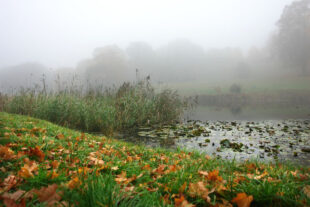 The days are getting shorter and the leaves starting to change, which means that fall is here. Now is the best time to prepare the koi pool for winter. The koi’s metabolism slows down as the water temperature drops. You will soon get a frost if you don‘t have one yet.
The days are getting shorter and the leaves starting to change, which means that fall is here. Now is the best time to prepare the koi pool for winter. The koi’s metabolism slows down as the water temperature drops. You will soon get a frost if you don‘t have one yet.
Pond flowers such as water lettuce and aterhyacinths must be removed from the pond before the cold sets in. The first signs of temperature drops are usually seen in water lettuce. These plants can cause water loss and poisonous compounds to enter the water. All tropical lilies must be removed and stored for next season. Cut back perennials to a smaller size and get rid of lily pads. Watercress and other plants should be kept to a 1- 2 foot area. Water iris tops should be removed to leave approximately 4-6 inches. The less surface area of the plants in the water, the easier it will be to empty the pond. An additional pump can be used if there are dead spots in the pond that has low water flow.
Pond fish can be fed high-protein pellets as long as the water temperature is above 70 degrees F. Their diet should be changed to include a mixture of wheatgerm and high-protein pellets. The colder the water, the more favorable the wheatgerm pellets will be. High-protein pellets can be more difficult to digest than wheatgerm pellets. This is because pond fish are likely to process their food slower as the temperature drops. They should only be fed wheatgerm pellets below 60 degrees F. This is because they won’t absorb any high-protein pellets.
 It is a good idea to feed your pond fish twice or three times per day during the first half of fall and once (or less) each day in the second half. You should quickly remove any unfinished food. Below 55°F, pond fish are unable to eat and wheatgerm pellets should only be used in moderation. Algae and other debris in the pond will provide all the nutrition the fish require by the end of the autumn period. Supplemental feeding is not necessary.
It is a good idea to feed your pond fish twice or three times per day during the first half of fall and once (or less) each day in the second half. You should quickly remove any unfinished food. Below 55°F, pond fish are unable to eat and wheatgerm pellets should only be used in moderation. Algae and other debris in the pond will provide all the nutrition the fish require by the end of the autumn period. Supplemental feeding is not necessary.
Clear the pond of any algae and net it. Also, get rid of any plants that won‘t make it through winter. To prevent tree leaves from falling into the pond, place a leaf net above the pond. Set up sandbags at the pond’s edge to prevent fish from being washed away in heavy rain or flooding.
Preparing your pond equipment is crucial for fall/winter. Your filtration system should be cleaned and the pond pump removed from the water. Once you have collected your equipment, you can clean it and maintain it at will. It’s not a good idea to clean it while it’s freezing outside.
You can keep the pump running all winter long by lifting it up so it draws water from the mid-water level. The pump should never be used to draw water from the bottom in winter. This keeps the water warmer for the fish.
Additional tip: Make sure there is a hole in your ice to allow for gas exchange. Fish can become seriously ill if you forcefully tear open the ice.
